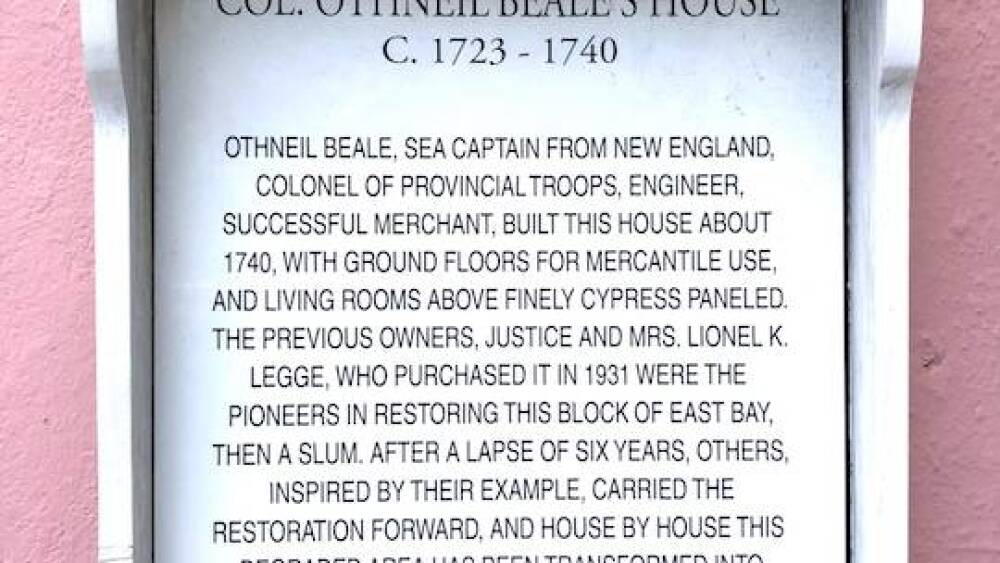Debunking the myths of Rainbow Row
One of Charleston’s most recognizable + photographed areas is the iconic Rainbow Row. The block of 13 colorful, private historic homes stretching along East Bay Street represents the longest cluster of Georgian row houses in the US.
Many know the age-old tall tales that claim to explain the meaning behind the boldly painted dwellings, but what is the real history of Rainbow Row? We’re here to set the record straight on some local legends about the vibrant colors of these historic homes.
Takin’ it back to the mid-18th century
In the mid-1700s, the row of houses on East Bay Street was originally constructed as a commerce center on the waterfront, serving the wharves + docks at the port. The shop merchants lived on the second floor, with their storefronts on the bottom level.
An area that once thrived fell into despair and mostly sat desolate until the 1920s when a suffragette stepped in to bring the area back to its prime.

Here’s a look a Rainbow Row in 1910.
Photo via markjonesbooks.com
An attempt at preservation
In 1920, Susan Pringle Frost, the founder of the now Preservation Society of Charleston, wanted to give new life to the buildings.
Frost purchased six of the homes but didn’t have the funds to restore them. So yet again, they sat until she found new buyers or folks willing to work with her to restore the area.
In 1931, Charleston adopted the country’s first Historical Zoning Ordinance, which helped maintain + protect the historical homes. That same year, Judge Lionel Legge + his wife Dorothy Porcher Legge purchased a section of the homes from 99 to 101 East Bay St. As they started renovating, they chose to paint the exterior of the houses in a bright, pastel pink — as a homage to the city’s Caribbean roots.
Fact or faction?
Throughout the late 1930s + 1940s, other homeowners in the neighborhood decided to copy their style — also painting their abodes in bold, Caribbean colors as a way to improve the aesthetics + keep the houses cooler during the warmer months. It was this action that helped the stretch of homes earn the name “Rainbow Row.”
Like most historic landmarks, Rainbow Row comes with numerous anecdotes about the original reason for the colors. But as far as history can tell, the stories that say the houses were painted brightly to point drunken sailors in the right direction, or those that state merchants used the colors to identify goods, are just that — stories.
The truth revealed
So, the real reason behind the vibrant colors is a combination of the Legge’s choice to paint their house pink, and their neighbors following suit to improve aesthetics + as a way to keep the houses cooler during the summer.
The homes
Each home is privately owned and city rules require owners to keep the home’s color — preserving the historic section of East Bay Street.
Here is a little background on the abodes that make up Rainbow Row.
Number 79-81
- The two-part building where Rainbow Row starts
- Built in the mid-19th century.
- Modern structure
Number 83
- The William Stone House
- Built in 1784
Number 87
- The James Gordon House
- Built in 1792
- Destroyed by a fire in 1778
- Rebuilt in 1792 by a Scottish Merchant, named (you guessed it) — James Gordon.
Number 89
- The Deas-Tunno House
- Built ~1770
Number 91
- Inglis Arch House
- Built and destroyed in a fire in 1778
- Reconstructed in 1782
- Sold to Nathaniel Russell in 1793
- New York playwright John McGowan purchased and updated the home in 1941.
Number 93
- The James Cook House
- Built in 1778
Number 95
- While the construction remains a mystery, as the original documents seemed to have vanished, the house was owned by Charles Cotesworth Pickney in 1779.
- The house was renovated was also renovated by John McGowan in 1938.
Number 97-101
- Col. Othniel Beale’s House
- 97 was originally purchased by Othniel Beale, who later built the adjoining 99-101 in 1740.
Number 103
- The Joseph Dulles House
- Built in 1787
- Developed by an ancestor of John Foster Dulles, the former Secretary of State (under President Eisenhower).
Number 105
- The Dutarque-Guida House
- Built between 1782-84, by Lewis Dutarque
- The next owner Giovanni Domenico Guida, added a storefront and the family grocery store was open until the 1960s.
Number 107
- The John Blake Building
- First purchased in 1791 by John Blake, a Revolutionary War patriot and state senator.
Did you know? More than 74,000 photos have been tagged with the hashtag #rainbowrow on Instagram. Professional photographers, tourists, newlyweds, fashionistas, + locals alike cannot seem to capture enough angles of the colorful charm.












